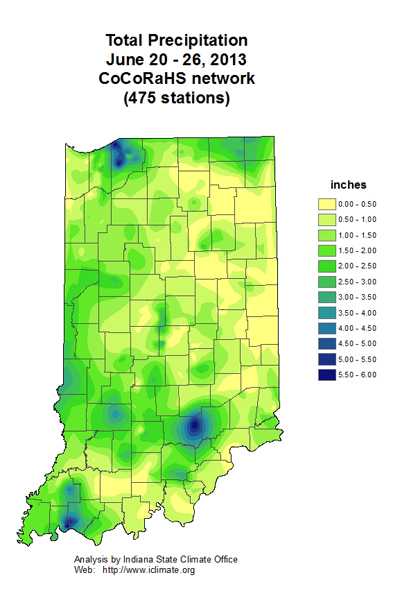USDA-NIFA Extension IPM Grant
Pest & Crop Newsletter, Entomology Extension, Purdue University
Western Bean Cutworm Moth Flight Begins – (Christian Krupke and John Obermeyer)
• Moths have begun emerging from soil, soon mating and egg laying will begin.
• Scouting for egg masses should commence once moth captures are increasing daily (soon, but not yet).
• Most Bt corn is protected.
Pheromone trapping began for western bean cutworm moths on Thursday June 20, and several have been captured in northern counties since then, refer to “Western Bean Cutworm Adult Pheromone Trap Report.” This is just the beginning of an extended moth emergence and flight, with their peak presence expected 2-3 weeks from now. Those in high-risk areas, i.e., sandy soils, high moth flight and WBC history, should be gearing up for field scouting of vulnerable cornfields.
Scouting should begin once moths are being captured nightly. In five different areas of a field, inspect 20 consecutive plants for egg masses which are laid on the upper surface of the top leaves of corn and/or larvae that may have hatched and crawled to the whorl and begun to feed. Usually the newest, vertical leaf is the best place to look for egg masses. Young larvae need pollen to survive, and female moths are most attracted to cornfields that are just about to pollinate. Moths will lay eggs on whorl stage corn when pre-tassel/pollinating corn is not available. Given our slightly later planting this year (vs. 2011 and 2012), there should be plenty of corn at that stage when moth flight peaks. Larvae may initially be found in leaf axils, feeding on pollen that has accumulated there. Later damage from larvae, as they feed deep in the whorl (attacking the tassel to get at pollen), will resemble corn borer or fall armyworm damage. Initially the damage will be subtle and not economically important (or even noticeable). Later stage larvae feed on corn kernels and can cause economic damage, and also can exacerbate ear rots, including Gibberella ear rot. In fields where Bt corn is planted, scouting and supplemental control should not be necessary. The proteins expressed in most currently available Bt corn hybrids (including Herculex, Smartstax, and Viptera hybrid lines) have been shown to be highly effective in controlling this cutworm species, although very light surface scraping will be seen on a few kernels at harvest time.
Western bean cutworm moths are often found resting down in the corn whorl during the day
![]()
Click here to see the Black Light Trap Catch Report
Western Bean Cutworm Adult Pheromone Trap Report
![]()
Palmer Amaranth Update – (Travis Legleiter and Bill Johnson) -
There have been confirmed populations of Palmer amaranth in thirteen counties in the state of Indiana as of June 26, 2013. These counties are no longer confined to just northwestern Indian as reported last fall and earlier this spring. We have recently confirmed populations in Adams and Henry counties on the eastern side of the state as well as Clay County in western Indiana. If you suspect that you have found Palmer amaranth in your fields, please contact Bill Johnson (wgj@purdue.edu or 765-494-4656) or Travis Legleiter (tlegleit@purdue.edu or 765-496-2121).
Links to recent Palmer publications from Purdue Weed Science:
<https://ag.purdue.edu/btny/weedscience/Documents/Palmer_ID.pdf>
<http://www.youtube.com/watch?v=wNgRvvnPQJ8>
<https://mdc.itap.purdue.edu/item.asp?itemID=21061>
Counties in red have been confirmed to have populations of Palmer amaranth present within the county. (As of 6/26/13)
![]()
![]()





